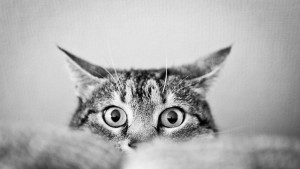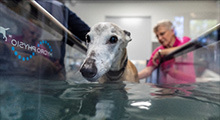The Importance Of Watching Your Pet’s Diet
As pet owners, one of our primary responsibilities is to ensure the well-being of our furry companions. Among the various elements that contribute to a pet’s health, diet plays a crucial role. Just like humans, pets require a balanced and nutritious diet to maintain a healthy weight and live their best lives. Monitoring your pet’s diet involves watching what they eat and how much they consume. Here, we explore signs of weight issues in pets, tips for dietary adjustments, and the benefits of maintaining a healthy weight.
Signs Your Pet May Be Overweight
Obesity in pets is a growing concern and can lead to serious health problems such as diabetes, heart disease, arthritis, and reduced lifespan. Recognising the signs of an overweight pet is the first step towards addressing this issue. One clear indicator is difficulty feeling your pet’s ribs without applying pressure. If your pet has a large belly or no visible waist when viewed from above, these are warning signs of excess weight. Additionally, if your furry friend exhibits lethargy or reluctance to exercise due to carrying extra pounds, it may be time for a dietary assessment.
Indicators Your Pet Might Be Underweight
On the flip side, being underweight can also pose significant health risks for pets. Signs that your pet may be underweight include visible rib bones with little or no fat coverage and a pronounced spine or hip bones. If your pet seems to have low energy levels or is constantly searching for food despite regular feedings, it could indicate insufficient caloric intake or an underlying health issue that requires veterinary attention.
Adjusting Your Pet’s Diet With Bagged Food
If you rely on commercially prepared bagged food for your pet’s meals, there are straightforward ways to make adjustments that suit their dietary needs. First and foremost, read the label carefully to understand the nutritional content and serving recommendations based on your pet’s size and activity level. High-quality bagged foods should list specific meat sources as primary ingredients rather than fillers like corn or wheat.
For overweight pets, consider switching to a lower-calorie formula designed for weight management. These products typically contain higher fibre content to promote fullness while reducing overall caloric intake. Conversely, if your pet needs to gain weight, look for calorie-dense formulas rich in proteins and healthy fats.
It’s essential to transition gradually between different foods over several days by mixing increasing amounts of new food with the old one to prevent digestive upset. Moreover, monitoring portion sizes by using standard measuring cups ensures consistency in daily intake.
Benefits Of Maintaining A Healthy Weight
Ensuring your pet maintains a healthy weight significantly enhances their quality of life. For starters, it reduces the risk of chronic diseases such as diabetes by helping regulate blood sugar levels through proper nutrition. A balanced diet coupled with regular exercise also supports joint health by alleviating undue pressure on bones and joints—particularly important for larger breeds prone to hip dysplasia.
Moreover, maintaining an ideal weight enhances mobility and energy levels—encouraging playful behaviour that strengthens bonds between you and your furry companion during fun activities like walks or playtime at home.
A well-managed diet contributes positively towards dental hygiene too! Chewing kibble helps remove plaque build-up from teeth surfaces—reducing tartar formation linked with gum disease which might otherwise necessitate costly veterinary interventions later down the line.
Furthermore—and perhaps most importantly—a nutritious diet fosters longevity; giving you more precious years together filled with shared adventures whilst minimising costly vet bills associated with treating preventable conditions arising from poor dietary habits. Contact our veterinary clinic, Pet Universe, to learn more about how you can manage your pet’s overall health with a proper diet.
Welcoming a puppy into your life is a joyful and heartwarming experience. Yet, alongside the excitement comes the responsibility of raising a well-adjusted and well-behaved companion. Puppy training is integral in setting the foundation for a happy and healthy relationship between you and your furry friend. Far from being a luxury or optional endeavour, puppy school ensures your new pet learns essential behaviours and social skills, ultimately enriching your lives.
The Importance of Puppy Training
For many pet owners, the idea of training a puppy may seem daunting at first. However, investing time and effort into training during the early months of your dog’s life is vital. A puppy’s brain is at its most malleable during this period, making it the perfect time for learning. Training establishes basic obedience and builds trust and communication between you and your pet. It provides your puppy with the structure and boundaries necessary to explore the world confidently and safely.
Behavioural issues are among the most common reasons dogs are surrendered to shelters. Proper training reduces the likelihood of these problems developing over time. Puppies that learn essential commands and social behaviours early are far more likely to grow into calm, manageable adult dogs. Additionally, training enriches a dog’s mental stimulation and prevents boredom, which can often lead to destructive actions.
Key Skills Taught in Puppy Training
While every dog is unique, there are certain universal skills that every puppy should learn to thrive. Commands like “sit,” “stay,” “come” and “down” are the building blocks for good behaviour. These seemingly simple cues help keep your dog safe and make daily interactions seamless and enjoyable.
Socialisation is another critical aspect of puppy training. Introducing your puppy to various environments, people and other animals early in life helps them develop the social skills necessary to handle diverse situations. Socialisation reduces fearfulness, aggression or anxiety that may arise when encountering new experiences.
Leash training and potty training are equally vital. Walking calmly on a leash ensures enjoyable outdoor outings for you and your dog, while potty training helps avoid accidents at home and teaches your pet to respect indoor spaces. Discovering these life skills during puppyhood ensures smoother integration into family life.
The Step-by-Step Process of Puppy School
Puppy training typically begins with positive reinforcement techniques, which reward good behaviour with treats, praise or play. This approach focuses on encouraging desired actions rather than punishing unwanted behaviours. For instance, rewarding your puppy every time they successfully sit on command teaches them to associate the action with a positive outcome.
Consistency is key throughout the training process. Dogs thrive on routines, and reinforcing commands repeatedly with the same tone and cues helps solidify their understanding. Maintaining consistency among family members is also important, as mixed signals can confuse your pup and hinder their progress.
Puppy school classes are an excellent way to complement your home training efforts. Led by experienced trainers, these classes provide a structured environment where puppies can practice obedience and interact with other dogs. Attending these sessions often introduces additional exercises tailored to specific challenges your puppy may face.
Patience is a vital component of the training process. Progress may not always be linear, and setbacks are a natural part of learning for the dog and the owner. Remaining calm and avoiding frustration ensures a more positive experience for everyone involved. Trainers often emphasise that success is not about achieving perfection but about developing a harmonious relationship with your companion. Remember, training is an ongoing commitment rather than a one-time task.
Why Puppy Training Is a Lifelong Investment
Puppy training lays the groundwork for years of mutual trust, understanding and companionship. Beyond the immediate benefits of teaching basic commands and social skills, the lessons learned during early training build a strong bond that will continue to deepen over time. A well-trained puppy grows into a well-mannered adult dog, making family life more enjoyable and less stressful for everyone involved.
For more information, contact us at Pet Universe.
Taking your dog to a rehabilitation treatment centre can be a daunting experience, yet it offers an invaluable opportunity for healing and recovery. Understanding what to expect during this process can significantly alleviate anxiety for both you and your canine companion. This blog aims to guide dog owners through the key aspects of rehabilitation treatment, ensuring a more seamless experience at a dog rehabilitation centre.
Understanding Dog Rehabilitation
Dog rehabilitation is an emerging field dedicated to helping pets recover from physical ailments and injuries. Much like human physiotherapy, these programmes focus on improving mobility, strength and overall well-being. Whether your dog has undergone surgery, suffered an injury or is dealing with chronic pain, a rehabilitation centre will provide specialised care tailored to your dog’s specific needs.
The first step typically involves an initial assessment. A qualified veterinarian or rehabilitation therapist will conduct a thorough examination to evaluate your dog’s history, physical condition and capabilities. They may assess your dog’s range of motion, strength and pain levels, gathering the necessary information to create an individualised treatment plan. This comprehensive approach ensures that each therapeutic method employed is appropriate for your dog’s unique circumstances.
The Treatment Process
Once assessments are completed, your dog will begin their rehabilitation programme. Treatment plans often include various techniques designed to promote healing. Physical therapy modalities such as manual therapy, hydrotherapy and exercise regimens may be integrated into the programme to enhance recovery. The emphasis here is on healing and on educating dog owners about how to continue their dog’s rehabilitation at home.
Hydrotherapy, for instance, is an effective approach for many dogs, allowing them to exercise without putting undue stress on their joints. This treatment can significantly improve muscle strength and range of motion, proving especially beneficial for overweight dogs or those suffering from arthritis. The gentle resistance of water enables dogs to build stamina while reducing the risk of further injury. Additionally, you can expect therapeutic exercises tailored to your dog’s capabilities, which may be adjusted regularly to suit their progress.
Emotional Considerations
It is essential to acknowledge that rehabilitation can be as emotionally taxing for dogs as it is physically challenging. Dogs may exhibit signs of anxiety or stress during their visits to the rehabilitation centre. It is crucial to remain calm and supportive during this process; your reaction will significantly influence your dog’s experience. The professionals at the centre are trained to handle these situations sensitively, ensuring your dog feels safe and secure.
Throughout the rehabilitation process, regular check-ins with the veterinary staff will provide insights into your dog’s status and progress. This ongoing communication nurtures trust and reassures you that your dog is receiving the best care. The staff will be keen to answer any questions and provide advice on how to manage your dog’s rehabilitation at home, including suggested exercises to promote further healing.
The Home Environment
In addition to the treatments at the rehabilitation centre, the home environment plays a pivotal role in your dog’s recovery. Adapting your living space to facilitate ease of movement can greatly assist in the rehabilitation process. It may be necessary to limit stairs and create comfortable resting places for your dog. The recovery phase also calls for consistent monitoring of your dog’s progress. Maintaining a log of their activities, behaviours and any noticeable changes will greatly assist your rehabilitation team in assessing their improvement and adjusting treatment plans if necessary.
The emotional bond between you and your dog is crucial during this time. Engaging in gentle play or quiet companionship can provide comfort and support. Your presence acts as a soothing balm, promoting a sense of security in your dog as they navigate their rehabilitation journey.
Participating in a rehabilitation programme at a dog rehabilitation centre is a proactive step toward ensuring the long-term health and well-being of your canine companion. While the process may feel overwhelming at times, knowledge and preparation can help alleviate uncertainty. Remember, the rehabilitation journey is not just about treatment; it is about nurturing hope and healing for your beloved pet.
Contact us at Pet Universe Veterinary Centre to learn more about rehabilitation treatments for your dog.
Acupuncture is a type of traditional Chinese medicine practice aimed at relieving pain and inflammation in the body. It’s a treatment that involves inserting very thin needles gently into specific points on the body to promote healing and relieve pain. While many people are familiar with acupuncture for humans, did you know that this ancient practice can also be beneficial for your pet as well?
As you read on, you will explore the wonders of acupuncture for pets, including what ailments it can treat, the benefits it provides, the differences between needle and laser acupuncture and how to determine if your pet could benefit from this alternative therapy.
What Is Acupuncture Used For?
Acupuncture has been used for centuries to treat a wide range of ailments in both humans and animals. For pets, acupuncture can help with conditions such as arthritis, joint pain, digestive issues, allergies and even anxiety. By stimulating specific points on your pet’s body, acupuncture can help improve circulation, reduce inflammation and balance the body’s energy flow. This holistic approach to healing can complement traditional veterinary care and provide relief for your pet without relying solely on medication.
What Are The Benefits Of Acupuncture For Pets?
The benefits of acupuncture for pets are numerous. Not only can it help alleviate pain and discomfort, but it can also improve mobility, boost the immune system and promote overall well-being. Many pet owners have reported seeing remarkable improvements in their furry companions after just a few sessions of acupuncture. Whether your pet is suffering from a chronic condition or simply needs some extra support during old age, acupuncture can be a gentle yet effective treatment option.
What Methods Of Acupuncture Are Available?
When it comes to acupuncture for pets, there are two main methods: needle acupuncture and laser acupuncture. Needle acupuncture involves inserting tiny needles into targeted acupoints on your pet’s body to stimulate healing. This traditional form of acupuncture is safe and effective when performed by a trained professional. On the other hand, laser acupuncture uses low-level lasers to target acupoints without piercing the skin. This non-invasive technique is ideal for pets who may be sensitive to needles or require a more gentle approach.
Will Your Pet Benefit From Acupuncture?
If your pet is experiencing chronic pain, mobility issues, digestive problems or behavioural issues that have not responded well to conventional treatments, it may be worth considering acupuncture as an alternative therapy. Acupuncture can also be used in conjunction with other treatment approaches. Before starting any new treatment plan for your pet, it is important to consult with a qualified veterinarian who specialises in holistic care to determine the best course of action for your pet’s needs.
Is Laser Acupuncture Better Than Needle Acupuncture?
In deciding between needle and laser acupuncture for your pet’s treatment needs, consider factors such as your pet’s temperament and sensitivity levels. While needle acupuncture is the traditional method with a proven track record of success, laser acupuncture offers a non-invasive option that may be more suitable for certain pets. Ultimately, the goal of both methods is to restore balance and harmony within your pet’s body so they can live their best life.
Acupuncture can be a wonderful healing modality for pets experiencing various health issues or simply in need of some extra support. Whether you choose needle or laser acupuncture for your pet, rest assured that they will receive gentle yet effective care aimed at promoting overall wellness. If you suspect that your pet could benefit from acupuncture services, schedule a consultation with a reputable veterinarian who specialises in holistic care. Your beloved companion deserves nothing but the best when it comes to their health and happiness.
Call our team of veterinary professionals at Pet Universe today.
As a pet owner, the welfare and security of your furry companion are probably some of your top priorities. One crucial step in ensuring your pet’s safety is by microchipping them. While it may seem like a small procedure, the impacts of microchipping can be life-changing.
In this blog post, we’ll dive into the importance of microchipping your pet and why every pet owner needs to consider it.
Identification and Reunion
Collars and tags can easily get lost, but a microchip embedded under your pet’s skin provides a permanent form of identification. If your pet ever goes missing, a microchip can significantly increase the chances of being reunited with them. All it takes is a quick scan by a vet or animal shelter using a microchip scanner to retrieve your contact information from the microchip database. This tiny microchip, about the size of a grain of rice, is implanted under your pet’s skin and contains a bar code which link s to your name, address and phone number.
Quick Injection to Implant
One of the common misconceptions about microchipping is that it is a painful procedure for pets. However, the process is quick and nearly painless for your furry friend. The chip is inserted just under the skin between the shoulder blades using a specialized needle, similar to a routine vaccination. Most pets do not even realize they have been microchipped, and the procedure only takes a few seconds to complete. With minimal discomfort for your pet, you can ensure their safety and security for years to come through this simple procedure.
Legal Requirements
In South Australia, microchipping your pet is a legal requirement. It’s not only necessary for the protection of your pet but also to ensure responsible pet ownership. Failure to comply with these laws result in fines of $2,500. All pets microchipped in South Australia are then logged onto the Dogs & Cats Online website. By ensuring your pet is microchipped, you’re not just abiding by the law and demonstrating responsibility as a pet owner but also providing a crucial safety measure in case your furry mate gets lost. This small act can bring immense peace of mind, knowing your beloved companion can be easily identified and returned home.
Peace of Mind
Knowing that your pet has a microchip can give you peace of mind in case they ever get lost or stolen. The thought of losing a beloved pet can be distressing, but having a microchip can increase the chances of a happy reunion. It also provides peace of mind, knowing that you have proactively ensured the safety and health of your beloved pet, ready to safeguard their wellbeing in any unexpected situations that may arise. Certain microchips such as those used at Pet Universe have an inbuilt thermometer which means your pet never has to put up with a rectal temperature exam.
Affordability and Longevity
Once a microchip is inserted into your pet, it becomes a reliable form of identification that can last a lifetime. This tiny device offers a permanent way to ensure your pet’s safety and secure their identification for years to come. The small cost of microchipping far outweighs the benefits it provides in terms of security and peace of mind. Consider it as a valuable investment in your pet’s safety and wellbeing, ensuring they receive the care and protection they deserve.
Microchipping your pet is a crucial step in ensuring their safety and security. From providing permanent identification to complying with legal requirements, the benefits of microchipping are numerous. As a responsible pet owner, it’s essential to consider the welfare of your pet and take proactive measures to protect them.
So, if you haven’t already, please consider microchipping your pet today and give yourself the peace of mind of knowing that your furry mate is always safe and secure. Get in touch with us now, don’t wait until it’s too late. Secure your pet’s safety and wellbeing for years to come by microchipping them today. Contact the team at Pet Universe for more helpful information.
As a pet owner, safeguarding your furry friend’s health and wellbeing should be one of your priorities. Some of the ways to secure your pet’s health are by providing a balanced diet, exercising them regularly and taking them to the veterinarian for regular checkups. Another way to protect your furry friends is by getting them vaccinated. In this blog post, we will delve into why pet vaccinations are vital for your furry friend’s health.
Pet Vaccinations Prevent Deadly Diseases
Pets that are not vaccinated are at a higher risk of contracting diseases such as rabies, distemper, parvovirus, hepatitis, and many more. These diseases can be fatal, and in some cases, they can infect humans too. It is essential to consult your veterinarian to know the appropriate vaccinations to be administered to your pet and the frequency at which they should receive them.
Saves You Money in the Long Run
While vaccines come at a cost, getting your pet vaccinated is more economical as it helps to prevent diseases that would cost significantly more to treat if your pet becomes infected. Vaccinations help to prevent critical illnesses that may require surgery or intensive care, which can be costly.
Required for Boarding and Travelling
If you plan on travelling with your pet or boarding them in a facility, it is usually required that they are up to date on their vaccinations. These requirements are set in place to prevent the spread of diseases in communal spaces. Therefore, getting your pet vaccinated helps prevent the hassle of rescheduling your travel plans or finding alternative boarding arrangements.
Protection for Other Animals
Vaccinations not only protect your pet but also other pets they come into contact with. Pets are social creatures, and they love playing with other pets. Having your furry friend vaccinated not only ensures its safety but also that of other pets they interact with, whether inside or outside your home.
Other Benefits of Pet Vaccinations
Aside from preventing diseases and protecting your pet’s health, vaccinations also have other benefits. For instance getting your pet vaccinated also helps to support the concept of herd immunity, where a large population is protected from contagious diseases if the majority are immune. This is especially important for pets that cannot be vaccinated for health reasons or young animals that have not yet completed their vaccination schedule.
Lastly, regular vaccinations can also serve as an opportunity for your veterinarian to conduct routine checkups and monitor your pet’s overall health. This can help catch any potential health issues early on, allowing for prompt treatment and better outcomes.
Pet vaccinations are an essential aspect of pet healthcare. They play a vital role in protecting your furry friend from deadly diseases, saving you money in the long run, fulfilling travel and boarding requirements, safeguarding other animals they come into contact with, and providing tailored vaccination schedules for your pets.
Vaccinations work by building your pet’s immunity to the diseases, making it better equipped to ward off infections. Consult our veterinarian today to know the best vaccination schedule for your furry friend and ensure you keep up with them to protect your furry friend from disease.
Kidney disease, which can lead to chronic kidney failure, is one of the most common ailments affecting senior cats. If caught early, the condition can be treated and managed fairly well. Fortunately, in many cases it comes on slowly, thus providing time for you and your veterinary team to develop a care plan.
Basics of Chronic Kidney Failure
There are two main types of kidney issues in cats—acute kidney diseases that come on quickly and chronic kidney diseases which develop more slowly over time. Acute kidney disease can affect a cat of any age, as it is typically caused by ingesting a toxin or suffering an injury. Chronic kidney disease, on the other hand, is most common in senior cats.
As the cat ages, kidney function begins to slow down naturally. This means any additional stresses upon the kidneys can wear down function further. Of course, young cats are not immune to chronic kidney disease. There are also congenital varieties of chronic kidney disease.
Causes of Kidney Failure
Natural aging only plays a small part in chronic kidney disorders. While some function loss is expected, it’s not a major concern unless the loss of function begins to drop too much or too quickly. Some common causes of chronic kidney function loss, particularly in senior cats, include:
- Kidney or urinary tract infections or blockages
- Gum diseases and tooth infections
- Comorbidity conditions, such as heart disease or a thyroid disorder
These conditions can be so minor as to go unrecognized, but the weeks or months of fighting off the infection or coping with the disorder can put unnecessary stress on the kidneys.
Chronic dehydration can also play a key role in developing a kidney disorder. Cats that don’t have plenty of access to clean water may not be drinking enough for healthy kidney function. Providing plenty of water and adding wet food to the diet may be necessary to ensure proper hydration.
Symptoms of Kidney Failure
An annual vet exam is the best way to monitor for a chronic kidney disorder. Your vet will take a blood and a urine sample to test for kidney issues. If the test results show high blood urea nitrogen and creatinine, or if there are signs of anaemia, then kidney disease is likely.
There are also behavioural symptoms that you may notice at home. These include:
- Urinating more frequently than usual
- Drinking water in greater volumes
- Blood in the urine
- Unexplained weight loss
- Constipation due to dehydration
- Loss of appetite
- More fatigue than usual
Not all of these symptoms are unique to chronic kidney disease, but they are all symptoms that warrant a vet visit.
Treatment for Kidney Failure
Treatment is more likely to be successful the earlier that the kidney disease is recognised. There are factors, like dehydration or a recent illness, that can skew kidney test readings. Your vet may recommend delaying treatment for a couple of weeks, at which time they will perform the tests a second time. Treatment will begin if this set of tests indicates that kidney disease is still present.
Chronic kidney disease can’t be cured, but it can be managed. Diet and hydration are key components of management. Your vet will prescribe a specialised diet for your cat. You may also need to provide additional hydration via more water stations, wet food, and under-skin hydration injections.
Medications will also be prescribed, especially if your cat’s condition is advanced. These medications may include those to treat comorbidities, such as thyroid conditions or high blood pressure, along with medications made to treat the kidney function-specific problems.
Contact Pet Universe to set up an appointment if you have noticed any troubling symptoms in your cat.
You’re doing all the right things, giving your cat as much love as you possibly can and then all of a sudden it turns around and bites you! You can’t work out for the life of you why this dreadful thing has occurred.
Your cat may be suffering from a skin condition or anxiety and this may be the cause of their reaction to you.
For more information about aggression issues in cats, click here.
Did you know we are the First Cat Friendly Practice in Adelaide? Click here to learn more about what it means to be an Accredited Pet Practice.
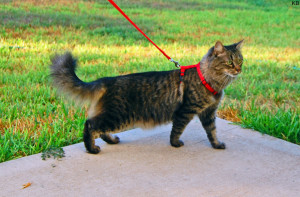
Obesity is one of the diseases that you as an owner have some control over and can be prevented. But if unfortunately your cat does fall ill to obesity, the disease can be cured and normal body condition can be established.
Obesity can shorten your cat’s life, this is why it is so important to take control of it once they become overweight.
For a list of steps to prevent and treat your cat’s obesity, click here.
For answers to some FAQ about overweight cats, click here.
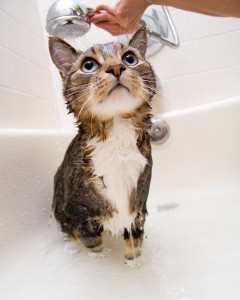
Naturally cats are highly fastidious. If you already own a cat, you will already be aware that cats are neat freaks! They spend majority of their day either grooming themselves or sleeping. But they could always use a helping hand from you.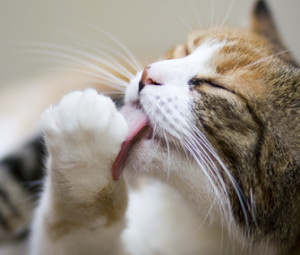
Grooming should be a relaxing and enjoyable time for you and your cat, so it s best to schedule a time when you are both
relaxed and in a good mood, perhaps after eating or having a play with them.
If you have never groomed your cat before, it’s best to keep the sessions short and then gradually increase over time. For more information on how to groom your feline friend, click here.
Next Page »

